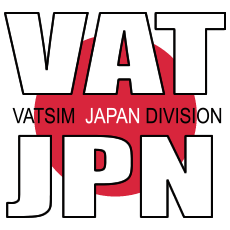SOP 東京洋上管制区
| VATSIM JAPAN | STANDARD OPERATING PROCEDURE | JPN2010001 |
| SUBJECT | TOKYO OCEANIC FSS | IN VATSIM USE ONLY |
| EFFECTIVE DATE | 16/JUN/2025 | Approved by VATJPN Air Traffic Management Team |
1.目的
このSOP(標準操作手順)は、東京洋上管制区を担当する管制官が国内外へ飛行する航空機を効率的かつ適切に処理できるよう標準的な操作手順を概説します。
This Standard Operating Procedure (SOP) outlines the procedures to be used by controllers working the Tokyo Oceanic Flight Service Station, to ensure that traffic flows are handled in as efficient and timely a manner as possible.
2.SOPの発行
このSOPはVATJPNのAir Traffic Management Teamにより作成されます。このSOPの維持・修正・更新・削除の必要性はVATJPN Air Traffic Management Teamによって審議されます。内容の不備や改善のための意見・報告は誰でもVATJPN Air Traffic Management Teamに送ることができます。
The Office of Primary Responsibility (OPR) for this SOP is the VATJPN Air Traffic Management. This SOP shall be maintained, revised, updated or cancelled by the VATJPN Air Traffic Management. Any suggestions for modification / amendment to this SOP should be sent to the VATJPN Air Traffic Management Team for review.
3.東京洋上管制区(RJJJ_FSS)
東京洋上管制区(RJJJ_FSS)とは別に示す広大な太平洋エリアをVATJPNが航空交通管制業務を提供することをVATSIMによって正式に認められた空域です。実際の世界では広大な洋上までレーダー波が到達しないためにパイロットからのポジションリポートをもとにノンレーダーによる航空管制が行われています。VATSIMでも太平洋上のノンレーダー管制を再現するために、この度VATJPNの担当空域として東京洋上管制区(RJJJ_FSS)を設立した。
※FSSでログオンした場合の最大VISレンジは1500nmでCTRの最大600nmに比べ広大です。
The Tokyo Oceanic FSS is established to provide uniform air traffic services over a large expanse of the Pacific Ocean. In the real world, radar coverage over this large area over the ocean is not possible, and "non-radar" methods are used to ensure the separation of aircraft. The objective of this SOP is to set forth simulated non-radar procedures using the radar client program, for controllers manning the Tokyo Oceanic Flight Service Station (FSS) position.
Note: When logged on as an FSS, the maximum visibility range is 1500 NM, higher than the 600 NM maximum range of a CTR controller.
4.手順
4-1.
東京洋上管制区はこの画像に示されるエリアの海面から上空を担当します。
The Tokyo Oceanic FSS shall own the airspace within the lateral limits depicted on this graphic, and from surface to unlimited.
4-2.
東京洋上管制区内を飛行する航空期間のセパレーションは以下のとおりとする。
・同経路同高度で飛行する航空機間の前後間隔は10分以上
・航空機間の垂直間隔は1,000ft以上 (RVSMの適用)
Separation while flying inside Tokyo Oceanic FSS airspace shall be as follows.
- lateral separation of at least 10 minutes between aircraft flying on the same route and altitude
- vertical separation of at least 1,000 ft between aircraft (application of RVSM)
4-3.
VRC/ASRCで使用するセクターファイルはVATJPN公式サイトのダウンロードページのものを使用します。
Sector files for use in VRC / ASRC are available on the "downloads" page of the VATJPN web site.
4-4.
VATSIMではFSSポジションで他のセクターを兼任できません。
RJJJ_FSSでログインした時は、東京ACC・福岡ACC・神戸ACCを兼任してはいけません。
FSSでログインできるのはVATSIMに許可された空域だけです。
The FSS position may not be merged with other sectors on VATSIM.
When logged on as RJJJ_FSS, one may not simultaneously assume responsibility for any of the Tokyo, Fukuoka or Kobe ACC positions.
Only airspaces specifically approved by VATSIM may be controlled as an FSS position.
4-5.
東京洋上管制区の管制官はVATJPNに所属でC1以上のレーティングを持つ管制官か、Pacific Oceanic LoAの対象者に限られます。洋上管制区を担当する管制官は"RJJJ_FSS"でログオンし周波数は"131.725MHz"を使用します。
A controller controlling Tokyo Oceanic FSS must be a member of VATJPN and have a rating of CTR or above, or be part of Pacific Oceanic LoA , and shall log on as "RJJJ_FSS" with frequency 131.725 MHz.
4-6.
東京洋上管制区に入域する航空機にはスコークコード"2000"を使用します。
Aircraft entering the oceanic airspace shall be assigned the beacon code 2000.
4-7.
東京洋上管制区を飛行するパイロットは高度計規正値を"29.92"にセットしなければなりません。
Aircraft shall use the standard altimeter setting of 29.92 while flying inside Tokyo Oceanic FSS.
4-8.
東京洋上管制区はノンレーダーであるので他のACCやFSSへ航空機を移管する際に、VRC/ASRCのレーダーハンドオフ機能を使うべきではありません。他の管制官との連絡調整はPMを使用することとし、その際には便名・移管FIXの到達予定時間(または境界到達予定時刻)・高度の情報が含まれること。
As RJJJ_FSS is a non-radar facility, the radar handoff feature shall not be used between ACCs and FSSes for control transfer. Generally, use PM to coordinate between different controllers; include pertinent information such as flight number, estimated time at handoff fix or boundary and altitude.
4-9.
東京洋上管制区ではSELCALを設定している航空機に対しSELCALシステムを再現します。管制官はSELCALシステムを使用するためにVRC/ASRCで何をどのように使うのかを知っているべきです。
RJJJ_FSS simulates the SELCAL system for aircraft with SELCAL set. Controllers shall understand how to use the relevant features in VRC / ASRC in order to simulate SELCAL.
4-10.
東京洋上管制区を飛行する全てのIFR機は定められた方式で飛行情報の報告を行わなくてはなりません。東京洋上管制区内の全てのFIXが位置通報義務点です。
報告すべき内容は以下のとおり。
・コールサイン
・通過した時刻とFIX名(または座標)と高度
・現在向かっているFIX名(または座標)と到達予定時刻
・その次のFIX名(または座標)
・現在のマッハスピード
All IFR aircraft flying inside Tokyo Oceanic FSS are required to give position reports according to a fixed format. All fixes on the oceanic tracks are mandatory reporting points.
Position report elements include
- Callsign
- Crossed fix (or coordinates), time and altitude crossed
- Currently approaching fix (or coordinates), and estimated time to cross
- Next fix (or coordinates)
- Mach number
以上


